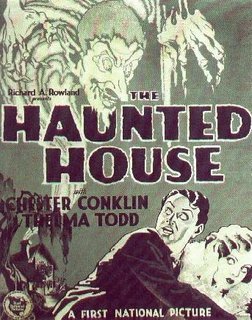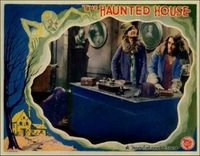
"Clanking chains. Clutching hands. Mysterious shadows. Deep groans or sudden cries of horror. Something hidden behind a secret panel. Footsteps overhead --- where there is no living creature. Wailing wind. Shining eyes in the dark. A horrible something that slithers across the floor. A dark hooded figure that rises from an obscure corner. Doors that close unaided. A gray thing that mops and mows in the shadows."
According to a syndicated publicity release for the late 1928 First National title "The Haunted House," a silent photoplay with a synchronized Vitaphone music and sound-effects soundtrack, all of the items quoted in the opening paragraph are "fine ingredients for a mystery film."
Today, we cannot easily determine for ourselves just how effective "The Haunted House" is, for it is yet another lost film of the transitional period between silence and sound. Like most lost films however, it's left traces of itself behind --- mostly print, some compelling static visual images, and... perhaps most revealing of all, it's sound discs.
According to a syndicated publicity release for the late 1928 First National title "The Haunted House," a silent photoplay with a synchronized Vitaphone music and sound-effects soundtrack, all of the items quoted in the opening paragraph are "fine ingredients for a mystery film."
Today, we cannot easily determine for ourselves just how effective "The Haunted House" is, for it is yet another lost film of the transitional period between silence and sound. Like most lost films however, it's left traces of itself behind --- mostly print, some compelling static visual images, and... perhaps most revealing of all, it's sound discs.
Vitaphone discs, like any phonograph record, would begin to show signs of wear after just a few plays and like their more familiar contemporary 78rpm counterpart, were prone to damage from mishandling, dropped needles, and of course, run-of-the-mill, drop-on-the-floor type of breakage. The main difference between the durability of a 78rpm music disc and its larger, thinner Vitaphone relative was that a skip or damaged groove in one of these discs would not only wreck havoc with synchronization, but that even a moderately worn surface would reproduce as loudly as hissing steam or crackling thunder. With a maximum of twenty plays suggested for optimum results, and duplicate sets of discs readily available to film exchanges and theater owners, the sound discs were --- for all purposes, disposable. It's this fact that has resulted in their high survival rate, especially in comparison to the films they once happily accompanied with a sense of purpose and importance. It's sadly odd, in a way, that all we have left for so many historically notable or at the least, intriguing films is just their disembodied voice --- and in some cases, not even that.
 Based upon the three-act stage play by Owen Davis, which ran for 103 performances at New York City's George M. Cohan theater in the waning months of 1924, the 1928 First National film version was directed by Benjamin Christensen, who --- it was announced while "The Haunted House" was in production, was contracted to helm a trio of similar thrillers that would continue with "Seven Footprints to Satan" (filmed and released in 1929) and conclude with "Shh! The Octopus!." (The latter film wouldn't appear on the screen until 1937, with a different director and, by then, a world away from the early sound period.)
Based upon the three-act stage play by Owen Davis, which ran for 103 performances at New York City's George M. Cohan theater in the waning months of 1924, the 1928 First National film version was directed by Benjamin Christensen, who --- it was announced while "The Haunted House" was in production, was contracted to helm a trio of similar thrillers that would continue with "Seven Footprints to Satan" (filmed and released in 1929) and conclude with "Shh! The Octopus!." (The latter film wouldn't appear on the screen until 1937, with a different director and, by then, a world away from the early sound period.)The scenario for "The Haunted House" concerns the heirs of a deceased eccentric millionaire searching for a hidden fortune in bonds within the confines of a stately yet somewhat derelict Connecticut summer cottage (of the twenty room, multi-floored variety) on the proverbial dark and stormy night. Their search is alternately hampered and aided by the presence of an insane doctor, weird apparitions in the form of a beautiful sleepwalking girl and other figures from the shadow world, a forbidding caretaker and all manner of puzzling cypher based clues and mechanical devices that need to be solved or avoided. At this point in the sad history of this film a "spoiler" is quite beside the point, so I'll venture a guess that little is lost by adding that, as it turns out, the deceased eccentric millionaire is quite alive and that he brilliantly arranged everything (including actors posing as the house's residents) to discover the true nature, worth and value of his would-be heirs.
 By all indication, the film performed well for First National during it's release in late October of 1928, where it was a natural Halloween Week choice for many theaters and advertised as such. Interestingly, while "The Haunted House" was being seen and heard in theaters across the country, there were also countless amateur theatrical productions of the same play being performed in schools, lodges and even churches --- with these productions often being advertised on the same page as print-ads for the film! Apparently, neither screen nor stage counterpart seemingly did one another much harm in ticket sales.
By all indication, the film performed well for First National during it's release in late October of 1928, where it was a natural Halloween Week choice for many theaters and advertised as such. Interestingly, while "The Haunted House" was being seen and heard in theaters across the country, there were also countless amateur theatrical productions of the same play being performed in schools, lodges and even churches --- with these productions often being advertised on the same page as print-ads for the film! Apparently, neither screen nor stage counterpart seemingly did one another much harm in ticket sales.By late 1929, all-talkie productions had cut such a huge swath and technical leap forward that a synchronized yet silent film such as "The Haunted House" would normally thought to be as quaint a relic as the earliest of Edison's film experiments. Yet, I've found that as late as March of 1930, "The Haunted House" was still being booked into smaller theaters on a limited run basis, accompanied by a serial chapter and a two-reel comedy. Clearly, the film still had "legs" enough to prompt it's revival --- which suggests "The Haunted House" promised what it delivered: "Fine ingredients for a mystery film." Perhaps one day, when we least expect it, we'll be able to see and hear for ourselves. Let's hope.
Now then, if you were crowded into the lobby of a theater in October of 1928, awaiting the next complete showing of "The Haunted House," and the heavy padded doors to the auditorium were to swing open every now and again, you couldn't help but experience an aural preview of what you'd soon be seeing. Our wait might well last a lifetime --- or maybe just a few years, but while we can, let's listen and imagine... via these three brief audio excerpts:
Audio Excerpt #1 - Main titles and introductory sequence, replete with a clock striking midnight and mournful wailing winds --- a sound effect which would prevail throughout much of the film, and accomplished by a mechanical siren being manually turned --- very slowly, according to a mid-1928 publicity placement.
"Haunted House" - Excerpt 1
Audio Excerpt #2 - As the heirs gather in the gloomy house's main room, the sound of wailing wind is momentarily broken by a ghostly voice singing "Love's Old Sweet Song," which is accompanied by not only the appearance of a sleepwalking damsel slowly descending the stairway, but the wild yowling of a nearby dog. The terrifying specter seemingly vanishes into a wall and the group rushes to discover where she went, tapping the wall panels in hopes of revealing a secret panel. Suddenly, one springs open!
"Haunted House" - Excerpt 2
Audio Excerpt #3 - In a sequence cited as especially effective by some contemporary reviews, Chester Conklin is called upon to aid in deciphering a musical clue which, when performed on an instrument in a particular way, would cause a much anticipated development in the film's plot. Here, Conklin plays a piano and a violin, then experiments at plucking the strings of the latter instrument --- which accomplishes the feat when a string breaks with an audible "pop" --- something which, by combination of image and carefully synchronized sound, worked to create a trill of pleasurable excitement among audiences in 1928.
"Haunted House" - Excerpt 3
Lastly, although "The Haunted House" escaped having a theme song or love theme, the frequent use of "Love's Old Sweet Song" as a vocal and leitmotif in the film's score largely qualifies it as one. I'll leave you with the option to listen to a stirring vocal duet performance of the timeless melody, as recorded in July of 1929 and released commercially on 78rpm.
Left: Eve (Ann) Sothern, as the sleepwalking, vocalizing and vanishing damsel, with co-star Thelma Todd.
Right: Lobby Card (Flora Finch, Barbara Bedford.)
Right: Lobby Card (Flora Finch, Barbara Bedford.)


No comments:
Post a Comment